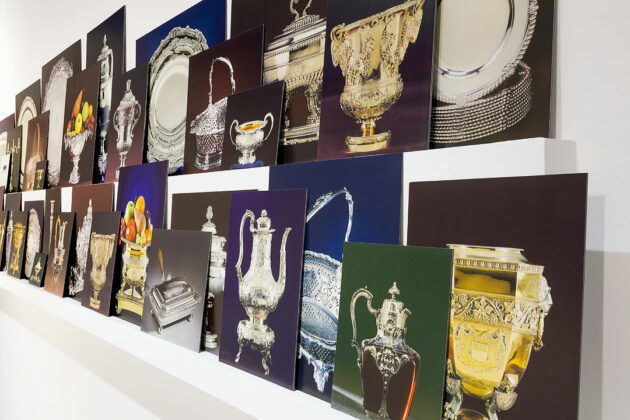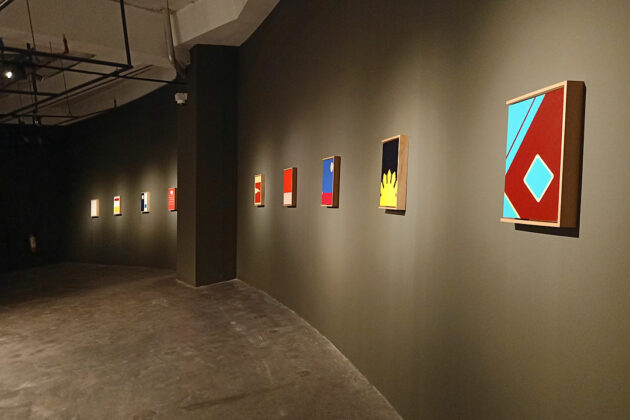‘Fear of Freedom’ tackles the Marcos loot
THREE rooms contain recreations of portraits of mythical beings, of millions of pesos worth of Regency-era silverware, of the finest of fine jewelry, as well as paintings based on propaganda materials. The space is inviting, sparking curiosity and fascination. However, the recreated objects are tainted by the corruption of a 20-year regime.
The entrance to an apparent crime scene is represented by an enlarged photo of the Malacañang Palace living room with torn tape on the doors. Its central image is the dictator’s portrait on a wall.
The display of objects is Pio Abad’s exhibition, “Fear of Freedom Makes Us See Ghosts,” which is on view at the third-floor galleries of the Ateneo Art Gallery (AAG).
A culmination of Mr. Abad’s 10-year project, the exhibition examines the conjugal dictatorship of Ferdinand and Imelda Marcos (1965-1986) by excavating silenced histories through archived documents, reproducing images, and replicating objects tainted by the regime’s corruption.
“It’s funny that the word ‘urgent’ is tied to something that I’ve spent 10 years working on,” Mr. Abad said during a walkthrough of the exhibition on April 18. “Having had the time to really dig deep into the toxic legacy of the Marcoses, it [is] equally gratifying and terrifying to present most of the project at this time,” he said, referring to the upcoming elections on May 9 which may see the dictator’s son, Ferdinand “Bongbong” Marcos, Jr., becoming the second “President Marcos.”
Across the enlarged photo of the Malacañang living room is a quote by Paolo Freire: “Fear of freedom, of which its possessor is not necessarily aware, makes him see ghosts.” The exhibition title is lifted from Mr. Friere’s Pedagogy of the Oppressed, a foundational text for the community of young activists and community organizers who emerged from the Ateneo de Manila University during the Marcos dictatorship — among them Mr. Abad’s parents, Butch and Dina.
“My parents were deeply involved in the anti-dictatorship movement, especially in organizing the social democratic movement that became part of the larger anti-Marcos movement. In 1980, they spent a year in campus arrest,” Mr. Abad said.
Upon entry to the exhibit’s first gallery, one sees a photograph taken by artist’s mother at Malacañang Palace on Feb. 25, 1986, the day the Marcoses escaped from the palace during the People Power uprising. It shows Mr. Abad’s father posing next to a portrait of Ferdinand Marcos depicted as the mythical figure, Malakas.
The artist’s parents were among first wave of protesters to enter the Marcoses’ private chambers, mere hours after the dictator’s family fled to Hawaii.
“They managed to get into the bedroom where this painting (of Ferdinand Marcos) was,” Mr. Abad said.
AESTHETIC RESISTANCE
Sharing the space in the first gallery are Mr. Abad’s replicated paintings by Evan Cosayco which portray the Marcos couple as Malakas and Maganda.
As the exhibition notes state: “In Philippine mythology, Malakas and Maganda were the first Filipinos who entered the world fully formed when a magical bird splits a single stalk of bamboo in half, revealing the pair cradled inside.”
During their 20-year rule, the couple assumed these mythological personas, presenting themselves as the center of cultural and political renewal in the Philippines.
Mr. Abad’s replicated portraits were painted black by a museum technician “as a show of protest” following the dictator’s burial at the Libingan ng Mga Bayani in Nov. 2016. The artist described painting the portraits black as “combating erasure with erasure.”
“It’s really an act of despair, of not really knowing what to do,” he added.
Another replicated image of Malakas and Maganda on display is an enlarged sculpture made from concrete and steel based on a mold by Anastacio Caedo.
THE FALSE IDENTITIES
The second gallery is a brightly lit room showcasing “The Collection of Jane Ryan & William Saunders.”
Jane Ryan and William Saunders were the false identities used by Imelda and Ferdinand Marcos to deposit $950,000 in four Swiss bank accounts at Credit Suisse in Zurich on March 20, 1968, during Ferdinand’s first term as President.
Through these and succeeding accounts, the couple purchased art and property. By the end of their regime, the Marcoses’ estimated wealth was $10 billion. The exhibition notes state that it was “one of the largest thefts in history and one that exploited the then nascent neoliberal system of offshore havens and shell companies.”
The items in the second gallery reconstruct an inventory of objects ranging from Old Master paintings to Regency-era silverware, Staffordshire porcelain to Louis IV-style furniture, and fine jewelry.
Mr. Abad’s research on the objects involved going through auction catalogues, government records, and visiting the Reagan archives in Los Angeles for correspondence of the United States’ involvement with Marcos.
On one side of the gallery are enlarged photos of 40 pieces from 78 pieces of sequestered Regency-era silverware recreated through giclee prints on semigloss paper, mounted in dibond. The original silverware was sold by Christie’s on behalf of the Philippine Commission on Good Governance (PCGG) which was tasked with retrieving the stolen wealth for the country. The 78 lots of silver were sold for $4.9 million.
Across the display of silverware are 23 ink drawings of items from the Samuels Collection, including rare 17th and 18th century English paintings, furniture, and pottery which were then housed at philanthropist Leslie R. Samuels’ apartment on 666 Park Avenue, New York. The Sotheby’s auction of the items was canceled abruptly in September 1981 when an anonymous buyer bought the apartment — and its contents — for $5.95 million.
At the center of the room is a display of postcards of the 90-piece collection of Old Master paintings. Visitors can take as many postcards home with them as they want. The reverse of the postcards contain text from news articles explaining how the artwork became part of the collection.
“I wanted to replicate the feeling that this physical experience of going to an inventory […] is a visceral thing,” Mr. Abad said, adding that it is “staging some kind of restitution.”
WHAT AND WHO FILIPINOS LOST
In the third gallery is a collaboration between the artist and his wife, British jeweler Frances Wadsworth Jones. The installation consists of 24 3D printed replicas of the jewelry collection that Imelda and Ferdinand Marcos tried to smuggle into the United States in 1986.
Known as the “Hawaii Collection,” it was seized by US Customs after the Marcoses landed in Honolulu. Valued at $21 million, the ill-gotten assets were repatriated to the Philippines to be auctioned off and liquidated. However, when the plans for the jewelry auction were finally settled in 2016, Rodrigo Duterte assumed the presidency.
Today, the “Hawaii Collection” remains locked in a vault in the Bangko Sentral ng Pilipinas.
Using images gathered from news footage and documentation from the aborted 2016 Christie’s auction, Ms. Wadsworth Jones digitally modelled 24 pieces of jewelry into 3D-printed resin sculptures.
The 3D-printed jewelry — which look like they were made of ivory — are displayed next to texts (written in Filipino) which tell what public projects each of the original pieces could have funded had they been sold in 2016.
Mr. Abad noted that the most expensive piece in the “Hawaii Collection” is an antique intense pink Taviz-cut Golconda diamond which could have funded the Bicol International Airport’s reconstruction and the renovation of the Sanga-Sanga Airport in Tawi-Tawi province.
“The Collection of Jane Ryan & William Saunders” can also be viewed digitally. By accessing the website www.janeryanandwilliamsaunders.com, the public can view the collection online and “take ownership” of the jewelry through Augmented Reality. Visitors can participate in the “digital restitution project” by posting their photos on Instagram tagging @janeryan_williamsaunders and using the hashtags #isauli and #digitalrestitution.
The final section of the exhibition is titled “For Silme and For Gene” and features an ongoing series of paintings that bear witness to the struggles of those who devoted their lives to fighting the dictatorship and its cruel legacy.
“They are abstract paintings, but they are also kind of weirdly tombstones — a quiet testament,” Mr. Abad said.
For the paintings, Mr. Abad appropriates the book cover designs of Ferdinand Marcos’ manifestos which detailed his political motives, including the defense of his decision to place the Philippines under martial law in 1972.
The text of the cover designs were erased to make them appear as memorials or abstract elegies to political leaders, community organizers, and student activists. The paintings are dedicated to Karina David, Archie Entengan, Bobby Gana, Chito Gascon, Liliosa Hilao, Evelio Javier, Boyet Mijares, Jesse Robredo, Dinky Soliman, and Noel Tolentino.
The last two paintings, For Dina I and For Dina II, are dedicated to the artist’s mother who passed away in 2017.
“This work has been a very productive process of grieving for what we lost as a nation, and for what I lost,” Mr. Abad said. “It begins with a photograph that she (his mother) took and ends with paintings dedicated to her.”
At a time when revisionism is rampant and freedom of expression is under threat, for Mr. Abad critical examination withstands.
“The critical voice has to continue,” he said. “That’s the only thing you hold that can’t be extinguished. I don’t think it will be.”
Pio Abad’s Fear of Freedom Makes Us See Ghosts runs at the Ateneo Art Gallery until July 30. The Ateneo Art Gallery is located within the Areté building of Ateneo de Manila University in Quezon City. Visits are strictly by appointment; admission is free. To schedule a visit, go to bit.ly/VisitAAG. For contact details and more information, visit www.ateneoartgallery.com — Michelle Anne P. Soliman









